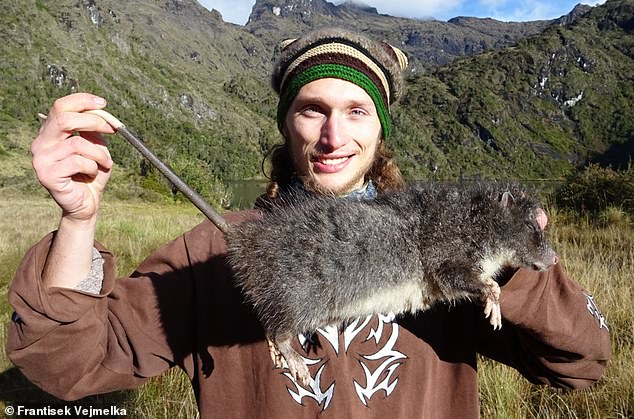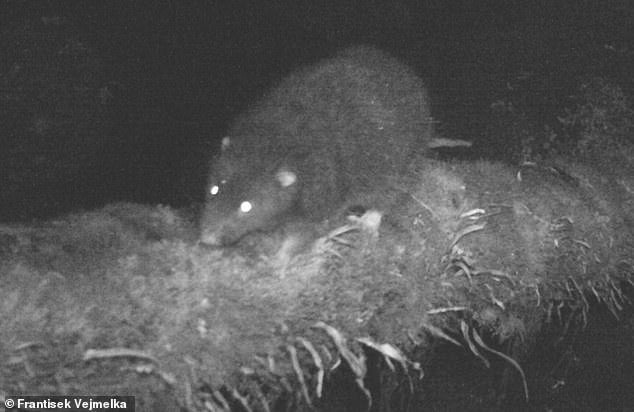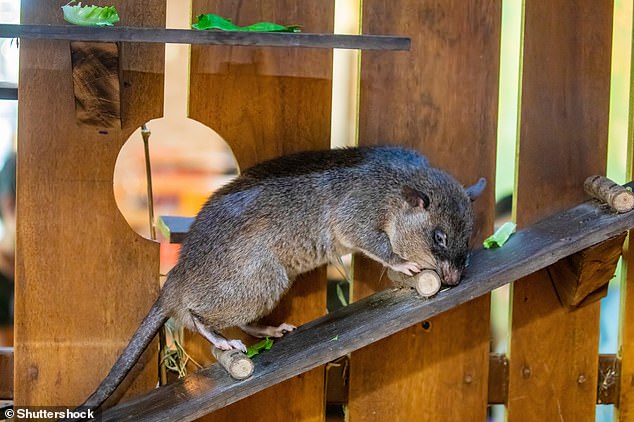If you have a fear of abnormally large rodents, you might want to look away now.
A scientist has discovered a whopping species of rat that measures more than 2.5 feet long – three times the size of a brown rat.
The ‘striking and formidable’ species, called the subalpine woolly rat, has sharp incisors, thick fur and clawed paws measuring three inches (8cm).
Astonishing footage shows one of the giant rats scampering across a tree branch in the dead of night, likely in search for food.
Fortunately, the shaggy-furred beast isn’t to be found in Britain and only lives in the steep highlands of Mount Wilhelm, Papua New Guinea.
The find was made by František Vejmělka at the Biology Center of the Czech Academy of Sciences and the University of South Bohemia, Czech Republic.
‘It’s astonishing that such a large and striking animal has remained so poorly studied,’ he said.
‘How much more is there to discover about the biodiversity of tropical mountains?’

A scientist has discovered a whopping species of rat that measures more than two-and-a-half feet. The proud discoverer František Vejmělka is pictured with the giant rat in its natural habitat at 12,000 feet (3,700 metres) above sea level. This specimen is dead, killed by a hunting dog belonging to local hunters

Mallomys istapantap caught on a camera trap in its natural environment. It is the first scientific observation of the rodent in the wild
Until now, the subalpine woolly rat (Mallomys istapantap) has been known to science only from a handful of museum specimens.
First described in 1989 based on historical museum material, it was last recorded 30 years ago and had never before been photographed.
But the Czech researcher’s new photos and video footage show the animal in its natural habitat for the first time.
During his six-month expedition, he worked with local tribes to survey Mount Wilhelm, the highest peak in Papua New Guinea which reaches 14,793ft (4,509 metres) above sea level.
Camera trap images and video recorded the elusive species inhabiting the cool, misty montane forests and grasslands at elevations of around 12,000ft (3,700 metres).
According to expert’s measurements, the subalpine woolly rat is a length of 2.7 feet (85cm) including the tail and weighs nearly 2 kilograms.
This compares to an average length of about 2.3 feet (70cm) and weight of 3.6 to 4.5 kilograms for the domestic cat.
Meanwhile, the average brown rat today has a body length of about 11 inches (28cm) and usually weighs 200-300g.

The site where Mallomys istapantap was recorded. The trampled vegetation on top of the log suggests it is frequently used by the animal to scamper across
Mr Vejmělka also gathered data on the mega-rat’s diet, parasites, activity patterns, movement, and other aspects of its lifestyle.
According to the expert, the elusive nocturnal species leads a hidden life in remote, hard-to-reach areas – which explains why it’s so understudied.
It climbs trees at night, hides in underground burrows or tree canopies during the day, and feeds exclusively on plant matter.
His work, published in the journal Mammalia, contributes to a deeper understanding of the biodiversity of New Guinea’s underexplored tropical mountains.
‘These are the first specimen records in 30 years for this spectacular mammal poorly known to science,’ said Mr Vejmělka, who also paid tribute to the local tribes who helped in.
‘Camera trap images and video, as well as photographs of the habitat and hunting with indigenous people, deepen our understanding of the activity patterns, locomotion, diet, intrageneric elevational partitioning, and behavioural ecology of the woolly rats.’
New Guinean woolly rats, together with the giant cloud rats of the Philippines, are the largest rodents belonging to the murine family.
They are found only in the steep highlands of New Guinea covered in pristine rainforest.

During his six-month expedition at Mount Wilhelm, František Vejmělka worked closely with local tribes while surveying the natural diversity

The Gambian pouched rat (Cricetomys gambianus, pictured) is generally identified as the largest known rat species
In the absence of other competing mammals, they have diversified over five million years into a remarkable variety of shapes and sizes.
While it’s undoubtedly a whopper, the the subalpine woolly rat is not the largest rat in the world.
The world’s biggest rat in terms of length is the Gambian pouched rat (Cricetomys gambianus), which reaches 3ft (0.9 metres) long, including the tail, which makes up half of its total length.
Another big rat species is the Malagasy giant rat (Hypogeomys antimena) found in Madagascar, which can grow to about 2ft.
But the largest rodents to ever have walked the Earth – including Josephoartigasia monesi and Phoberomys pattersoni – are now extinct.
Unusually large animals from history known as ‘megafauna’ typically died out due to climate and environmental shifts, plus human hunting.









